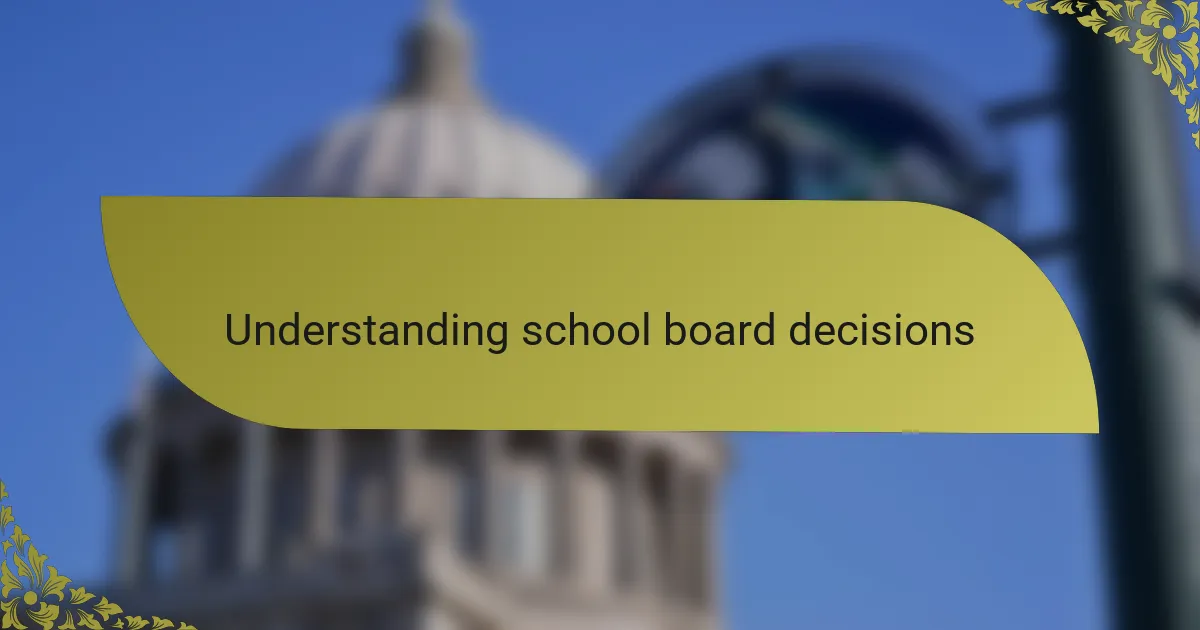Key takeaways
- Louisiana school boards are influenced by local governments, which can tailor education policies to community needs through engagement and funding decisions.
- Community involvement is vital, as collective efforts can amplify concerns and create a united front for advocacy, leading to more impactful discussions.
- Preparation and respect in advocacy, along with sharing personal experiences, can foster constructive dialogue and influence positive changes in school board decisions.
- Building relationships with board members and understanding the community’s needs enhances communication and effectiveness in advocating for educational improvements.

Overview of Louisiana school boards
Louisiana school boards play a crucial role in shaping educational policies and practices within the state. Comprised of elected representatives, these boards make decisions on budgets, curriculum, and school administration. I’ve seen firsthand how passionate individuals can influence these decisions, especially when community voices come together to advocate for change.
The diversity among Louisiana’s school boards is notable, as different regions face unique challenges and solutions. For example, urban districts may prioritize technology integration, while rural areas often focus on access to resources. This variation makes each board’s decisions impactful in different ways.
Here’s a comparison of urban versus rural school boards in Louisiana, highlighting their distinct characteristics:
| Aspect | Urban School Boards | Rural School Boards |
|---|---|---|
| Budget Priorities | Technology and Infrastructure | Access to Basic Resources |
| Community Engagement | Higher Participation Rates | Stronger Personal Connections |
| Challenges | High Student Enrollment and Competition | Limited Funding and Staff |

Role of local government
Local government plays a critical role in shaping education policies that directly affect students and families. I remember attending a school board meeting and feeling the weight of the decisions being made. It struck me how local representatives could influence our children’s educational landscape, making their roles incredibly significant.
The decisions made at this level can be quite personal. Here are some key aspects of how local government influences school board decisions:
- Direct Accountability: Local officials are elected by the community, meaning they must answer to the parents and taxpayers.
- Customization of Policies: Every community has unique needs, and local governments can tailor educational strategies to address those specific requirements.
- Funding Allocations: Local taxes often fund schools, so government decisions directly impact the resources available for education.
- Engagement Opportunities: School boards often hold public meetings, allowing community voices to be heard and considered in decision-making.
- Partnerships and Alliances: Local government can foster partnerships with businesses and nonprofits to enhance educational programs and resources available to students.
Reflecting on my own experiences, I’ve seen firsthand how important it is for community members to actively participate in these discussions to ensure our voices shape a positive future for our schools.

Understanding school board decisions
Understanding school board decisions can feel daunting at times, but it’s crucial to grasp how these choices impact our communities. I remember the first time I attended a school board meeting, feeling overwhelmed by jargon and complex agendas. However, as I started to engage more actively and ask questions, I realized that understanding the decision-making process could empower me and my peers.
Often, school boards grapple with budget considerations, curriculum changes, and policy updates, which can seem distant from everyday student life. I’ve witnessed firsthand how vocal community members can sway these decisions, especially when they come prepared with facts and genuine concerns. It’s a reminder of how our involvement can shape a better educational experience for our children.
| Aspect | Details |
|---|---|
| Decision-Making Process | Involves community input, budget reviews, and policy evaluations. |
| Key Stakeholders | School board members, parents, teachers, and students. |
| Impact Factors | Budget constraints, educational standards, and community needs. |

Strategies for influencing decisions
When it comes to influencing school board decisions, one effective strategy I’ve experienced is forming alliances with other concerned parents and community members. This collective approach amplifies our voice and demonstrates to board members that we represent a larger faction of the community. It’s powerful to walk into a meeting knowing that others stand with you, united by a common goal for our children’s education. Have you ever noticed how a group can create a more impactful presence than an individual alone?
Another strategy that has proven valuable is the preparation of concrete proposals backed by data. I remember attending a board meeting where a fellow parent presented a detailed plan for enhancing after-school programs. It wasn’t just a pitch; it was driven by research on student benefits and community needs. This level of preparation shows that we’re serious and informed, making it harder for decision-makers to dismiss our suggestions. What a difference it makes when we approach these discussions with well-researched facts!
Lastly, I’ve found that staying respectful and understanding—even when disagreements arise—can go a long way in these meetings. A positive attitude fosters open dialogue and often leads to more constructive conversations about changes we wish to see. I recall a moment when our group faced resistance, but by acknowledging the board’s challenges and framing our ideas constructively, we were able to keep the lines of communication open for future discussions. How do you think a respectful approach could change the tone of a tough conversation?

Building community support
Building community support is essential when influencing school board decisions. I found that reaching out to parents and local organizations created a strong network of allies. It was through informal gatherings and open conversations that we discovered shared concerns about educational resources and curriculum updates. This connection helped us articulate our collective needs more effectively.
As I engaged with community members, I noticed their passion for improving the schools echoed my own. One particular meeting yielded surprising enthusiasm; parents who initially appeared indifferent became advocates when they saw the potential for change. This transformation shows how critical community involvement is.
Here’s a simple comparison table highlighting key dynamics of building community support:
| Aspect | Community Support |
|---|---|
| Importance | Creates a united voice for advocacy |
| Engagement | Encourages open dialogue and trust |
| Impact | Affects school board decision-making |

Personal experiences in advocacy
Reflecting on my journey in advocacy, I remember the initial uncertainty I felt when stepping into my first school board meeting. Surrounded by seasoned activists, my voice seemed small. Yet, as I listened and later shared my thoughts, I discovered that even a single story—like my child’s struggles with outdated textbooks—could resonate with others and spark meaningful discussions. Have you ever felt the power of your personal experience connect with a larger cause?
One memorable moment stood out when my peer and I presented a petition signed by over fifty parents concerned about lunch quality in schools. The palpable energy in the room was electrifying. I realized then that it wasn’t just about the lunches; it was about health, well-being, and the commitment of our community to advocate for our children. That day taught me how united frontlines can leave a lasting impression on decision-makers.
As I honed my advocacy skills, I learned that sharing personal anecdotes during meetings fosters empathy. I vividly recall sharing my child’s excitement about a potential new art program, which shifted the atmosphere towards enthusiasm. This emotional appeal not only humanized our arguments but also reminded board members of the real children and families behind their decisions. How often do we forget that behind every statistic are real lives affected by our advocacy?

Lessons learned from influencing boards
Throughout my journey in influencing school board decisions, I’ve learned that persistence and patience are key. I vividly remember attending my first board meeting, feeling anxious yet excited as I presented my ideas. It took time for my voice to be recognized, but each small victory felt rewarding, reinforcing my resolve to stay engaged in the process.
From these experiences, I grasped several important lessons:
- Building relationships with board members is crucial; they are more likely to listen if they trust you.
- Clear, concise communication makes your message stand out, so I always prepared succinct points.
- Understanding the needs and concerns of the community helps frame your suggestions in a way that resonates.
- Listening actively to feedback, even when it’s difficult, shapes a more collaborative atmosphere.
- Sharing personal stories can humanize your proposals and create emotional connections.